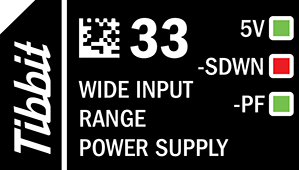#33, M1T: Wide Input Range Power Supply

Function: Wide input range power supply with 5V output, shutdown control, and power failure detection
Form factor: M1T
Category: Power supply module
Special needs: [INT] (optional)
Input voltage: 8–60V (accepts voltage dips down to 6V and spikes up to 100V)
Output voltage: 5V
Output current: Continuous 1.5A and peaks up to 2A
Temperature range: –40°C to +85°C
Mates with: #18, #19, #20, #21
See also: #09, #10, #12, #23, #25


Details
Tibbit #33 is ideal for powering Tibbo Project System (TPS) devices from the popular 12V, 24V, and 48V DC input voltages. The Tibbit is capable of supplying up to 1.5A(1) of current from 8~60V input voltage and in the entire industrial temperature range from –40°C to +85°C. The module can handle voltage dips down to 6V and spikes up to 100V, which makes it suitable for battery-powered and automotive applications. Tibbit #33 also features transient input voltage, reverse input voltage, reverse output current, output current (short circuit), and temperature (overheating) protection.
Multiple Tibbits #33 can be used to increase the available current, for power redundancy, or for load sharing(2).
Combine Tibbit #33 with #18 (it has a power jack and two terminal blocks), #19 (DB9M), #20 (nine terminal blocks), or #21 (four terminal blocks).
- To ensure your system's reliability and longevity, derate this value for input voltages above 48V, especially in high ambient temperature conditions. While driving the Tibbit at the specified maximum current will not lead to an immediate failure, it may reduce the Tibbit's life. We recommend a maximum current of 1.3A for sustained operation at input voltages above 48V. When in need of higher currents in harsh conditions, consider using more than one power Tibbit for load sharing.
- Be aware that when you use multiple power Tibbits, their grounds (IO4) are interconnected (tied together) through the TPS.
Control Lines
- Tibbit #33 has a dedicated shutdown (–SDWN) line. Pull the line LOW to disable the Tibbit.
- The Tibbit also features a power fail (–PF) output. The following table details the output's state under different operating conditions:
| Table 1 — –PF Line States | |
|
Condition |
–PF Line State |
|
The switching regulator is on and is able to maintain the output voltage within the 4.5–5.5V range |
HIGH (no power failure) |
|
The switching regulator is on, but the output voltage is outside of the 4.5–5.5V range (for example, because of excessive load or insufficient input voltage) |
LOW (power failure) |
|
The switching regulator is shut down (the –SDWN line is driven LOW) |
LOW (Tibbit powered off) |
|
Input power removed from the Tibbit's power input (IO1) |
When the input power is removed, the output voltage of the Tibbit will start to drop. Once the output voltage falls below 4.5V, the state of the –PF line will change to LOW. As the output voltage continues to drop, it will eventually reach the point where the Tibbit's switching regulator is unable to operate, at which point the –PF line will switch back to HIGH. Hence, disconnecting the input power will cause a negative pulse on the –PF line. The pulse is typically 50–100ms in duration. It can be detected by the TPS' GPIO line running in the interrupt mode. |
Note: Tibbo recommends monitoring the –PF line with an interrupt routine instead of polling the status of the line. Using interrupts will help catch transient failures or instabilities that cannot be detected through polling.
LEDs
Tibbit #33 features two green LEDs and one red LED:
- The green "5V" LED is connected to the 5V output of the Tibbit's switching regulator. It is on when the regulator is outputting power. The LED will be off when the regulator is not outputting power, even if the host TPS system is receiving power from some other source (for example, a second Tibbit #33).
- The red –SDWN LED turns on when the host processor pulls the –SDWN line LOW, thus disabling the Tibbit's switching regulator.
- The green –PF LED is on when the corresponding –PF line is LOW. –PF line behavior is detailed in the table above.
Library Support
Tibbit #33 works as soon as a power source is connected, and no code is required to make the Tibbit function in your system. If you want to monitor the –PF line, you can use an interrupt line. You can use AppBlocks for configuration and creating your application. It will also help you implement the shutdown, reset, and restart mechanisms for your application.
Additional Info
Handling Current and Power Spikes
